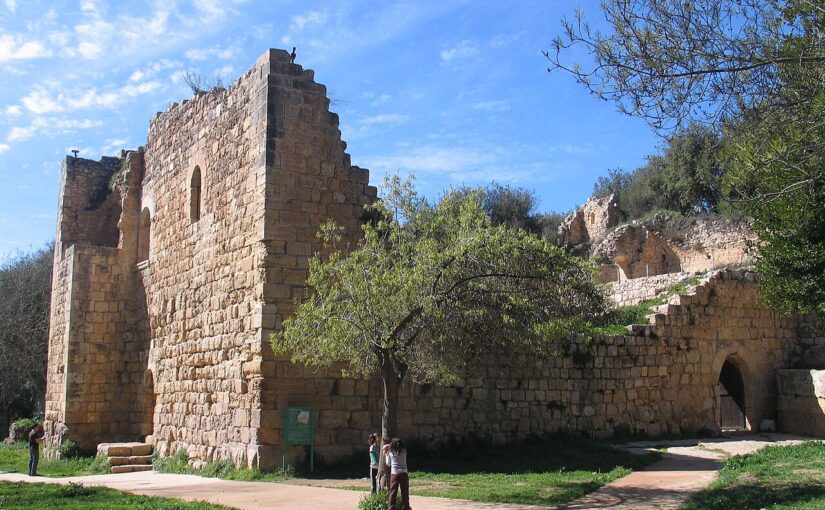Just west of Jerusalem, the gentle hills slip into valleys strewn with streams and ancient stone. Here, where olive trees mingle with fragrant pines and the air is fresh, lies Aqua Bella (known today as Ein Hemed). The landscape shimmers with greenery even in the heat of summer. Wildflowers spill onto pathways beside the river and old stone bridges arch gracefully over bubbling waters. In the morning, birds rustle the canopy, and hikers set out toward the ruins with a sense of anticipation that grows as the soft light reaches between the branches. Nature and heritage are inseparable here. The site invites both adventure and rest with shaded lawns, tranquil meadows, and clear springs that have kept travelers content for centuries.
A Strategic Haven from Crusader Days
Aqua Bella’s story begins with movement. For centuries, its valley was a natural gateway between the Mediterranean and the Holy City. Romans once marched their troops past the springs. By the Crusader period, this route was vital, linking pilgrims to Jerusalem across rugged terrain. The Crusaders named the spot Aqua Bella—”beautiful water”—reflecting both admiration and recognition of its strategic value. In the twelfth century, the Kingdom of Jerusalem fortified key points along the road. A solid manor house and courtyard rose at Ein Hemed, likely around 1140, commissioned by King Fulk.
The structure was formidable, with thick walls stretching twelve meters high and a pair of vaulted stone halls flanking a central courtyard. Multiple gates controlled access while arrow slits and a squat tower kept watch for travelers and potential foes. The building soon passed to the Hospitaller Order whose knights patrolled nearby fortresses and managed care for pilgrims and soldiers. Parts of Aqua Bella served as a farm, an infirmary, and perhaps even as a retreat for weary knights, making use of the spring’s restorative waters and the valley’s relative peace.
Throughout the ages, the fortress adapted to changing powers. It has lingered in the local memory as Khirbat Iqbala, later as Deir el-Benat (“the convent of the maidens”), entwining Crusader stonework with memories of later Arab and Jewish communities.
Military and Cultural Legacy
While Aqua Bella never led an army into battle, its presence helped secure the pilgrimage route to Jerusalem, a crucial function for both commerce and faith. The Crusaders proved masterful at blending European construction with local materials. Chisel marks on some stones still tell tales of the stonemasons who worked in the valley nearly a millennium ago. The fortress not only monitored travelers, it marked a boundary between wild hills and cultivated lands, encouraging settlement and farming. The Hospitallers’ legacy survives in the careful layout of the halls, where they offered healing and respite to those on the long journey south.
Even after the Crusaders departed, the spring continued as the heartbeat of the valley. The local farm provided fruit, olive oil, and simple luxuries for generations. Later, the British Mandate and Israeli periods saw new settlements built nearby, but the ruins persisted, their stones silently watching the landscape change.
Serene Retreat for Modern Explorers
Today, Ein Hemed National Park protects what was once Aqua Bella. The park feels timeless, with the Crusader ruins resting amid meadows and the natural stream. Families picnic under towering trees. The air rings with birdsong and the lively sounds of visitors. The old courtyard is still visible, flanked by impressive walls and archways. Spring water pools in quiet corners, inviting toes on hot days, and flowers bloom among the old stones. The park is both welcoming and mysterious, offering wheelchair-accessible trails, wilder hiking paths, and smooth lawns perfect for a break beside the stream.
Even the construction resonates with history. Step inside the fortress and sense the thick cool air where knights may once have rested, or look up at column capitals and arches that catch the sunlight just as they did for Crusaders centuries ago.
Why Aqua Bella is Worth a Visit
Ein Hemed promises a rare combination: genuine medieval ruins, lush scenery, and the charm of history alive in every stone and drop of water. Its proximity to Jerusalem makes it an easy day trip for those craving an escape from city bustle. Whether you linger over a picnic, wander among flowers, explore ancient arches, or ponder the stories etched into the walls, Aqua Bella enchants with both beauty and heritage. The site offers not only relaxation and recreation, but a portal into the time when knights traveled under these trees and builders left lasting marks on the land. To walk here is to experience living history, woven with the peace and splendor of the Judean hills.
Image by Bukvoed.
If our work has inspired you, helped you grow, or simply brought a little warmth to your day, consider supporting Thalysia.com with a small donation. Your contribution helps us continue exploring ancient landscapes, documenting local traditions, and celebrating the art of living well.
